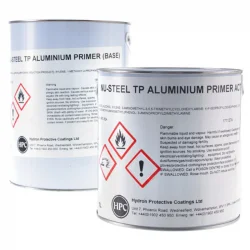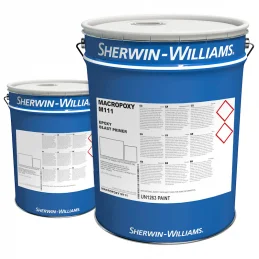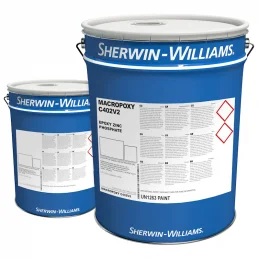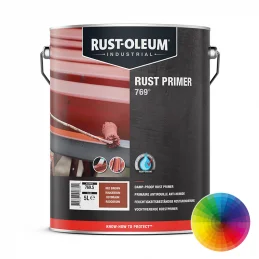- There are no more items in your cart
- Shipping Calculated at checkout
-
Sub-Total (inc. VAT)
£0.00
Need Help?
Moisture Tolerant Primers
Moisture Tolerant Primers for metal are a vital solution for ensuring long-lasting protection in environments exposed to damp conditions. These specialist coatings offer excellent adhesion to metal surfaces even in situations where traditional primers would fail due to moisture presence. They are engineered for various industries including marine, construction, and industrial maintenance, where resistance to rust and corrosion is essential. By safeguarding metal structures and equipment from early degradation, these primers ensure durability and extended service life, reducing downtime and maintenance costs. Contact technical support for product compatibility guidance. Click for more info.

Hydron Nu-Steel TP Aluminium Primer
Nu-Steel TP Aluminium Primer is a high build epoxybased coating, part of the Nu-Steel TP System. For use on properly prepared steelwork. Excellent opacity giving good obliterating power prior to the application of Nu-Steel TP Finish, and excellent adhesion to clean, bright galvanised steel For use on properly prepared steel such as...

Sherwin-Williams Macropoxy M111
Sherwin-Williams Macropoxy M111 is a 2-pack epoxy zinc phosphate primer for application to surfaces which have been prepared by wet abrasive blasting. It may also be applied to grit blasted surfaces and for surfaces prepared by UHP water blasting where existing blast profile is exposed. Please note: This product is made to order subject to...

Sherwin-Williams Macropoxy C402V2
Sherwin-Williams Macropoxy C402V2 is a high build 2-pack epoxy zinc phosphate primer/buildcoat, which provides anti-corrosive protection of carbon steel surfaces prepared by abrasive blast cleaning. Network Rail endorsed Touch dry in up to 90 minutes at 23°C For use in internal/external exposed conditions, including offshore,...

Rust-Oleum 769/780 Damp-Proof Rust Primer
Available in a wide range of colours. Ideal for application on slightly damp or dry metal surfaces. Requires minimal surface preparation. Durable corrosion protection. Optimal rust inhibition. Certified for C4 exposure conditions (ISO 12944) and VOC compliant (375 g/l). Buy A Paint Colour Sample
Need Help?
Need Help?
What Are Moisture Tolerant Primers and How Do They Differ from Other Primers?
Moisture Tolerant Primers for metal are a highly specialised class of coatings formulated to adhere effectively to metal surfaces even when residual moisture is present. Unlike traditional primers, which generally require completely dry substrates to achieve proper adhesion and performance, these primers are engineered to bond with metal surfaces in environments where moisture is unavoidable. This makes them invaluable in settings where controlling humidity or moisture is impractical, such as in marine environments, outdoor construction projects, or industrial sites where condensation is frequent.
The primary difference between moisture-tolerant primers and other types of metal primers lies in their advanced chemical formulations. Most traditional primers will fail to adhere or cure correctly in the presence of moisture, leading to blistering, peeling, and early corrosion of the underlying metal. In contrast, moisture-tolerant primers are designed with hydrophobic properties or advanced curing agents that allow them to interact with both the metal surface and the moisture present, forming a stable, durable protective layer. This allows users to avoid lengthy delays caused by waiting for surfaces to dry fully, providing a more flexible and efficient solution for time-sensitive projects.
Another key differentiator is the level of corrosion protection provided by moisture-tolerant primers. While some standard primers offer corrosion resistance in dry environments, they often fall short in harsher, wetter conditions. Moisture-tolerant primers, however, excel in preventing rust and corrosion, even in the most humid or water-exposed environments. This enhanced performance is critical in industries where long-term durability and protection from environmental factors are crucial, including marine, construction, and industrial maintenance sectors.
In terms of their versatility, moisture-tolerant primers are typically compatible with a wide range of topcoat finishes and can be used in conjunction with various metal types, such as steel, iron, aluminium, and galvanised metals. This flexibility makes them an ideal choice across multiple market sectors, particularly where both initial protection and compatibility with finishing coats are necessary.
Top Features and Benefits of Moisture Tolerant Primers
1. Exceptional Adhesion in Damp Conditions
Moisture-tolerant primers are formulated to bond with metal surfaces even when moisture or condensation is present. This ability to adhere in less-than-ideal conditions eliminates the need for a fully dry surface, a common requirement for standard primers. The superior bonding ensures that the primer forms a stable base coat for subsequent layers, leading to longer-lasting protection against corrosion. For industries working in high-humidity environments, this feature is crucial, allowing ongoing projects without weather-related delays.
2. Outstanding Corrosion Resistance
One of the core benefits of moisture-tolerant primers is their ability to prevent corrosion in environments where metal surfaces are exposed to water, humidity, or industrial chemicals. These primers are designed to create an impermeable barrier that prevents moisture from seeping into the metal substrate, which is a common cause of rust. By preventing the onset of corrosion, moisture-tolerant primers extend the service life of metal structures and equipment, saving industries significant costs in repairs and replacements.
3. Time-Saving Application
Traditional primers often require dry surfaces and ideal weather conditions for application. Moisture-tolerant primers circumvent these restrictions by allowing application in damp or humid environments, significantly reducing project delays. This is particularly important in time-sensitive industries such as construction, marine maintenance, and manufacturing, where extended downtime due to poor weather can be costly. By using a moisture-tolerant primer, workers can continue applying protective coatings without waiting for surfaces to dry fully, streamlining workflows.
4. Wide Compatibility with Metal Types
Moisture-tolerant primers are engineered for use on various metal substrates, including steel, iron, galvanised metal, and aluminium. This versatility ensures that they can be applied across a wide range of industries, from marine applications and industrial equipment to infrastructure projects and automotive components. Their compatibility with numerous topcoats also means they can be used as a base layer under different finishing systems, providing flexibility in project specifications.
5. Enhanced Durability and Longevity
The chemical makeup of moisture-tolerant primers enables them to bond securely to metal surfaces, forming a protective layer that remains durable over time. Their resistance to moisture and environmental degradation means they can offer long-term protection, reducing the need for frequent maintenance or recoating. This extended durability makes them a cost-effective solution for businesses looking to minimise operational downtime and maintenance expenses over the lifespan of their assets.
Common Uses of Moisture Tolerant Primers for Metal
1. Marine and Offshore Structures
Marine environments are among the most challenging for metal protection due to constant exposure to saltwater, rain, and varying humidity levels. Moisture-tolerant primers are ideal for protecting metal components of ships, offshore platforms, and harbour infrastructure. The continuous exposure to moisture in these settings means that traditional primers often fail to provide adequate protection, leading to rapid corrosion and structural deterioration. Moisture-tolerant primers are applied to ship hulls, bulkheads, and even smaller components like ladders, railings, and deck fixtures to prevent rust and ensure the longevity of the vessel or structure. Their ability to adhere to damp or partially submerged surfaces allows for maintenance and repairs to be carried out efficiently without needing to wait for complete drying, ensuring that operations remain on schedule.
For offshore platforms, these primers are indispensable in maintaining the integrity of critical infrastructure such as support beams, pipelines, and anchoring systems. Given that these structures are constantly exposed to saltwater, spray, and condensation, a highly moisture-resistant primer is essential to preventing corrosion that could compromise the platform’s safety and functionality.
2. Industrial Equipment and Machinery
Industries such as manufacturing, power generation, and oil and gas production rely on heavy machinery and equipment that operates in environments prone to condensation, temperature fluctuations, and occasional spills of water or chemicals. Moisture-tolerant primers are used to protect metal surfaces on machinery like compressors, conveyor systems, cranes, and storage tanks from corrosion. Since these machines often operate in demanding conditions where temperature changes lead to the formation of condensation, applying a standard primer would be insufficient. Moisture-tolerant primers, however, provide a durable protective layer that guards against rust even in wet or humid environments, ensuring the equipment remains operational for longer periods.
Additionally, these primers are often used on metal surfaces that come into contact with aggressive chemicals, oils, or solvents. Their chemical-resistant properties make them particularly useful in refineries, chemical processing plants, and other industries where both moisture and harsh substances pose a threat to the integrity of metal components.
3. Bridges and Metal Infrastructure
Bridges and large metal structures, such as those found in transport and civil engineering projects, are constantly exposed to the elements, including rain, humidity, and salt from nearby roads or bodies of water. Moisture-tolerant primers are applied to the steel frameworks of bridges, ensuring that the underlying metal remains protected from the onset of corrosion. Given the high safety and longevity standards required for infrastructure projects, ensuring that the metal components remain rust-free is critical.
The use of moisture-tolerant primers in these settings allows contractors to apply protective coatings without the need for ideal dry weather conditions, which can be a significant advantage on large-scale projects where delays due to weather can be costly. This is especially useful in coastal regions where structures are exposed to higher levels of humidity and saltwater spray.
4. Water Treatment and Sewage Facilities
Water treatment plants and sewage facilities operate in damp, moisture-laden environments where metal surfaces are constantly exposed to water, chemicals, and varying humidity levels. Moisture-tolerant primers are used extensively in these facilities to coat metal pipes, tanks, and structural supports. The constant exposure to water and chemical treatments means that standard primers would deteriorate quickly, leading to rust formation and potential contamination or equipment failure.
Moisture-tolerant primers provide a robust barrier that prevents corrosion, even when applied to surfaces that are in direct contact with water. This is particularly important in tanks, clarifiers, and metal walkways that are continuously exposed to water or chemical runoff. By using these primers, water treatment facilities can ensure that their equipment remains operational and that metal components do not degrade prematurely, reducing the need for costly repairs or replacements.
5. Agricultural and Food Processing Equipment
Agricultural machinery and equipment used in food processing facilities often operate in environments where moisture and temperature changes are frequent. In food processing plants, metal equipment such as storage tanks, conveyor belts, and metal hoppers are regularly cleaned with water or chemical agents, exposing them to conditions that promote rust and corrosion. Moisture-tolerant primers are applied to these surfaces to protect the metal from degradation, ensuring that the equipment remains hygienic and functional over long periods.
Similarly, in agricultural settings, moisture from rain, irrigation systems, or humidity can lead to rusting of farming equipment like tractors, ploughs, and silos. Moisture-tolerant primers are used to protect these valuable assets from corrosion, enabling farmers to avoid costly equipment replacements and ensuring the machinery remains in good working order for extended periods.
6. Automotive and Transport Vehicles
In the automotive and transportation sectors, vehicles and equipment are regularly exposed to moisture, either from rain, road spray, or condensation. Moisture-tolerant primers are commonly applied to the undercarriages of vehicles, wheel wells, and chassis components to prevent rusting and corrosion. This is especially important in regions where roads are salted during winter months, as salt can accelerate the corrosion process when combined with moisture.
For commercial vehicles, such as trucks, buses, and trailers, maintaining the structural integrity of metal components is vital for safety and performance. Moisture-tolerant primers ensure that these vehicles remain rust-free, reducing the risk of breakdowns or expensive repairs due to corrosion damage.
7. Building and Construction Sites
Construction sites are often exposed to variable weather conditions, with metal structures, scaffolding, and frameworks coming into contact with rain, humidity, or even snow. Moisture-tolerant primers are applied to protect these metal surfaces during both the construction and maintenance phases of a building project. Their ability to adhere to damp metal ensures that the structure remains protected from rust, even if work must continue during less-than-ideal weather conditions.
In the construction of high-rise buildings, industrial plants, or metal-framed warehouses, these primers play an essential role in safeguarding structural components from moisture-related damage, ensuring the long-term durability of the building. Given that construction sites often face tight schedules, the quick-drying properties of moisture-tolerant primers help keep projects on track, even in wet weather.
FAQs
Can moisture-tolerant primers be applied directly to rusted metal?
Yes, moisture-tolerant primers are often designed to be applied to rusted metal surfaces, provided they have been properly prepared. Surface preparation, such as wire brushing to remove loose rust and debris, is typically required to ensure optimal adhesion and protection.
How long do moisture-tolerant primers take to dry?
Drying times vary based on the specific product and environmental conditions, but generally, these primers are formulated for fast drying, even in damp conditions. Typical drying times range from a few hours to 24 hours, depending on humidity and temperature levels.
Are moisture-tolerant primers suitable for underwater use?
While many moisture-tolerant primers are water-resistant and ideal for damp environments, not all are suitable for direct underwater use. It is important to consult with a technical expert to determine if a specific primer is rated for submersion.
Can these primers be used in both hot and cold conditions?
Yes, moisture-tolerant primers are designed to perform well across a range of temperatures. They can be applied in both hot and cold environments, although it is always advisable to check the manufacturer’s guidelines for the recommended temperature range for application.
Do moisture-tolerant primers work on all metals?
Most moisture-tolerant primers are formulated to adhere to a wide variety of metals, including steel, aluminium, and galvanised surfaces. However, it is always recommended to verify compatibility with the specific metal type before application.
Is it necessary to use a topcoat over a moisture-tolerant primer?
While moisture-tolerant primers provide excellent protection on their own, applying a compatible topcoat is often recommended for added durability, UV protection, and customisation of finish. The topcoat also extends the lifespan of the coating system.
Can these primers be used indoors as well as outdoors?
Yes, moisture-tolerant primers are versatile enough to be used in both indoor and outdoor environments. Their ability to protect against moisture makes them an ideal choice for metal surfaces in basements, factories, and storage facilities, as well as outdoor structures.
What kind of surface preparation is needed before applying a moisture-tolerant primer?
Surface preparation typically includes cleaning the metal to remove dirt, oil, and loose rust. In most cases, light abrasion is required to create a profile for optimal primer adhesion, although full-scale sandblasting is not always necessary.
Can these primers be applied in humid climates?
Absolutely. Moisture-tolerant primers are specifically formulated to be applied in humid conditions, making them an excellent solution for areas where moisture levels are consistently high.
Is there a specific moisture-tolerant primer for marine environments?
Yes, there are moisture-tolerant primers formulated specifically for marine environments, where the presence of saltwater and constant moisture exposure necessitates even stronger corrosion resistance. Marine-grade primers are particularly robust and are ideal for ships, piers, and offshore platforms.
